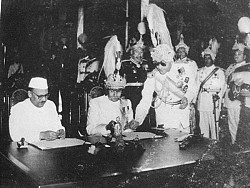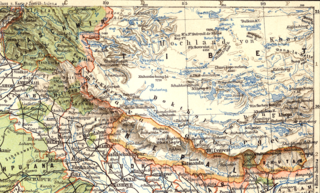
A treaty is a formal, legally binding written agreement between actors in international law. It is usually made by and between sovereign states, but can include international organizations, individuals, business entities, and other legal persons. A treaty may also be known as an international agreement, protocol, covenant, convention, pact, or exchange of letters, among other terms. However, only documents that are legally binding on the parties are considered treaties under international law. Treaties vary on the basis of obligations, precision, and delegation.

The Treaty of San Francisco, also called the Treaty of Peace with Japan, re-established peaceful relations between Japan and the Allied Powers on behalf of the United Nations by ending the legal state of war and providing for redress for hostile actions up to and including World War II. It was signed by 49 nations on 8 September 1951, in San Francisco, California, at the War Memorial Opera House. Italy and China were not invited, the latter due to disagreements on whether the Republic of China or the People's Republic of China represented the Chinese people. Korea was also not invited due to a similar disagreement on whether South Korea or North Korea represented the Korean people.

The Treaty of Rapallo was an agreement signed on 16 April 1922 between the German Republic and Soviet Russia under which both renounced all territorial and financial claims against each other and opened friendly diplomatic relations. The treaty was negotiated by Russian Foreign Minister Georgi Chicherin and German Foreign Minister Walther Rathenau. It was a major victory for Russia especially and also Germany, and a major disappointment to France and the United Kingdom. The term "spirit of Rapallo" was used for an improvement in friendly relations between Germany and Russia.

The Locarno Treaties were seven agreements negotiated in Locarno, Switzerland, during 5 to 16 October 1925 and formally signed in London on 1 December, in which the First World War Western European Allied powers and the new states of Central and Eastern Europe sought to secure the post-war territorial settlement, in return for normalising relations with the defeated German Reich. It also stated that Germany would never go to war with the other countries. Locarno divided borders in Europe into two categories: western, which were guaranteed by the Locarno Treaties, and eastern borders of Germany with Poland, which were open for revision.
A war of aggression, sometimes also war of conquest, is a military conflict waged without the justification of self-defense, usually for territorial gain and subjugation.

The Sino-Japanese Peace Treaty, formally the Treaty of Peace between the Republic of China and Japan and commonly known as the Treaty of Taipei, was a peace treaty between Japan and the Republic of China (ROC) signed in Taipei, Taiwan on 28 April 1952, and took effect on August 5 the same year, marking the formal end of the Second Sino-Japanese War (1937–1945).
The Prevention of Nuclear War Agreement was created to reduce the danger of nuclear war between the United States and the Union of Soviet Socialist Republics. The agreement was signed at the Washington Summit, on June 22, 1973. The United States and the U.S.S.R. agreed to reduce the threat of a nuclear war and establish a policy to restrain hostility.

The United States is not a state party to the Rome Statute of the International Criminal Court, which founded the International Criminal Court (ICC) in 2002 as a permanent international criminal court to "bring to justice the perpetrators of the worst crimes known to humankind—war crimes, crimes against humanity, and genocide," when national courts are unable or unwilling to do so.

The 1950 India-Nepal Treaty of Peace and Friendship is a bilateral treaty signed by the Kingdom of Nepal and the Republic of India to establish a close strategic relationship between the two South Asian neighbours. The treaty was signed at Kathmandu on 31 July 1950 by the last Rana Prime Minister of Nepal Mohan Shumsher Jang Bahadur Rana and Indian ambassador to Nepal, Chadreshwar Narayan Singh and came into force the same day as per Article 9 of the Treaty. Rana rule in Nepal ended just 3 months after the treaty was signed. The treaty allows free movement of people and goods between the two nations and a close relationship and collaboration on matters of defense and foreign policy.
The Franco-Soviet Treaty of Mutual Assistance was a bilateral treaty between France and the Soviet Union with the aim of enveloping Nazi Germany in 1935 to reduce the threat from Central Europe. It was pursued by Maxim Litvinov, the Soviet foreign minister, and Louis Barthou, the French foreign minister, who was assassinated in October 1934, before negotiations had been finished.

The Minority Treaties are treaties, League of Nations mandates, and unilateral declarations made by countries applying for membership in the League of Nations that conferred basic rights on all the inhabitants of the country without distinction of birth, nationality, language, race or religion. The country concerned had to acknowledge the clauses of the treaty as fundamental laws of state and as obligations of international concern placed under the guarantee of the League of Nations. Most of the treaties entered into force after the Paris Peace Conference.

The Treaty of Tianjin, signed on June 9, 1885, officially ended the Sino-French War. The "unequal treaty", or colonial treaty, restated in greater detail the main provisions of the Tianjin Accord, signed between France and China on May 11, 1884. As Article 2 required China to recognize the French protectorate over Annam and Tonkin established by the Treaty of Hue in June 1884, implicitly forcing China to abandon its claims to suzerainty over Vietnam, the treaty formalized France's diplomatic victory in the Sino-French War.
An agreement concluded between the Soviet and the Norwegian governments in Christiania on 2 September 1921 to regulate their relations. It was ratified by the Soviet government on 19 September and by the Norwegian government on 1 October. The agreement went into effect on 1 October 1921 and was registered in League of Nations Treaty Series on 19 December 1921.
The U.S.–German Peace Treaty was a peace treaty between the U.S. and the German governments. It was signed in Berlin on August 25, 1921 in the aftermath of World War I. The main reason for the conclusion of that treaty was the fact that the U.S. Senate did not consent to ratification of the multilateral peace treaty signed in Versailles, thus leading to a separate peace treaty. Ratifications were exchanged in Berlin on November 11, 1921, and the treaty became effective on the same day. The treaty was registered in League of Nations Treaty Series on August 12, 1922.

The Sino-British Treaty for the Relinquishment of Extra-Territorial Rights in China, or the Sino-British New Equal Treaty, was a bilateral treaty concluded between the British and the Chinese governments in Chungking (Chongqing) on 11 January 1943. The formal name of the treaty was Treaty Between His Majesty in Respect of the United Kingdom and India and His Excellency the President of the National Government of the Republic of China for the Relinquishment of Extra-Territorial Rights in China and the Regulation of Related Matters.
The Bucareli Treaty, officially the Convención Especial de Reclamaciones, was an agreement signed in 1923 between México and United States. It settled losses by US companies during the Mexican Revolution. It also dealt with the illegality of potential expropriating American landholding and subsoils for the sake of Mexican public use as well as the ways of calculating compensation and forms of payment, given expropriation was well needed.
The Treaty of Amity and Commerce between His Majesty the Magnificent King of Siam and the United States of America, or Roberts Treaty of 1833, was the first treaty between the United States and an Asian nation.

The Nepal–Britain Treaty was first discussed in 1921 and the final treaty was signed on 21 December 1923 in Singha Durbar. The treaty was the first formal acknowledgement by the British that Nepal, as an independent nation, had the right to conduct its foreign policy in any way it saw fit and was considered to be “a great achievement of 25 years of Chandra Shumsher’s diplomacy.” The treaty was recorded in 1925 in the League of Nations.
The Treaty of Amity, Economic Relations and Consular Rights between the United States and Iran was signed in Tehran on August 15, 1955, received the consent of the U.S. Senate on July 11, 1956 and entered into force on 16 June 1957. The treaty is registered by the United States to the United Nations on 20 December 1957. The official texts are in English and Persian. It is sealed by plenipotentiaries Selden Chapin (U.S.) and Mostafa Samiy (Iran). The Treaty has served as the jurisdictional basis for various international legal disputes between the United States and Iran, including the International Court of Justice (ICJ) cases Oil Platforms and Alleged Violations of the 1955 Treaty of Amity, Economic Relations and Consular Rights. In October 2018, the United States provided notice that it would be withdrawing from the Treaty following Iran's use of the Treaty as a basis to challenge the U.S. imposition of sanctions under the Joint Comprehensive Plan of Action (JCPOA) in the Alleged Violations case.










